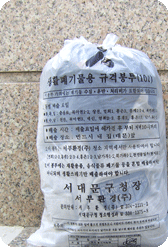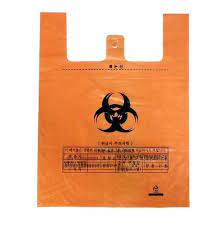How to throw your garbage in Korea - How do I recycle?
- Tony Giny
- Mar 24, 2022
- 6 min read
Updated: Apr 27, 2022
For food waste, if you don't live in an apartment building and the owner didn't buy the special garbage dumpster (
The recycling process in South Korea is so different than other countries and authorities, as well as the citizens, take it very seriously as well. Therefore, it is important to inform yourself in advance about this topic, or if you fail to comply with the recycling rules it may result in severe fines (as in the experience the fine is usually a minimum of 1 million KRW). And the fines, if they gather more and more, unpaid, may adversely affect any visa extensions or changes.
What do we recycle in South Korea?
The following is currently being recycled: food scraps, plastic, glass, cardboard, textiles, vinyl (bags and packaging). In Korean this category is called: 재활용 쓰레기, sometimes you can see this sign in the area of the garbage.
What do we do with the rest of the garbage?
All other things not listed above cannot be recycled and are therefore thrown away in a special bag in designated areas as non-recyclable or 일반 쓰레기.
How do we recycle?
Recycling varies depending on the neighborhood and the type of housing you live in.
Therefore, when you move, we advise you to ask the owner or manager of the accommodation about recycling rules. Many times, (especially in homes and apartments) you will encounter various posters in the elevator or on the staircase with written and visual information. With any luck, there will be an English version as well.
In general, recycling is done as follows:
1. In dorms and gosiwons, in our experience, most of the garbage recycling is done by staff employed. Or, at most, you will be able to see the classic dumpsters in the common area, labeled, one for each type of garbage.

2. In villas or houses, the same rules apply as in the apartment, with minor modifications. Garbage is stored in special bags, everything is thrown in front of the villa/house (unless there is an area with the dumpster, delimited) and the garbage disposal program is written on the special bags and it is usually more generous than in the case of apartments. In this case, it may be 3-4 days per week between 6 PM - 9 PM. Check for the poster that is usually at the entrance or on each floor, case by case.
3. In apartment complexes, on the other hand, the process is a bit more complex. For the food remains, there is a special digitalized food collection device, but for that, you need a special card (if you did not receive it from the landlord, ask the administration for the lease).
Expect to be charged based on how many pounds of food you throw away. How much the less you waste, the lower your maintenance bill. Non-recyclable garbage is thrown in the designated area, usually next to the household waste device. Textiles also have a special green dumpster called 의류 쓰레기. All three can be thrown away on any given day at any hour. Instead, for recyclable waste, there will be a certain fixed interval when you can throw it in the designated area. Where exactly? If you go in the evening, you'll find it out after the cardboard hills were already created by the other tenants.
Where do we buy special bags?
Garbage bags can be bought from any 24h store such as GS25/CU/7Eleven or neighborhood stores. Be careful when you ask the seller for the bags, and mention for which neighborhood you need it, also what kind of garbage and how many liters the bag should be. For example, you can say, 일반 쓰레기 10L 봉투 한 묶음. And you will get what you asked for, which is a dozen (12 bags) of 10L bags for non-recyclable garbage designated for a certain area (usually the stores around your home sell only for that area).
Again, special garbage bags exist only for leftover foods, vinyl, and non-recyclable garbage and each has a different color code (be aware the color can be different based on district or city). In my experience, the yellow ones are for food waste or 음식물 쓰레기, the pink ones for reusable or 제사용 종량제 쓰레기, the white ones are for non-recyclable, and the blue transparent ones are for recycling or 종량제 쓰레기물 쓰레기. Also, remember that non-recyclable or 일반 쓰레기 can use also the market bags (different colors depending on the city or district), on which is written the type of garbage. Also, in the case of Corona or any other toxic waste, you should use a special orange bag.

For food waste, if you don't live in an apartment building and the owner didn't buy the special garbage dumpster (gray with the orange or green cap), you should buy it yourself. Usually, on the district office (구청) website you can find where to buy it and how much it is. The smallest one is around 5,000 KRW. Be aware that some areas don't let you just throw away food waste in front of the building so you will have to buy a dumpster.
Paper: newspapers, calendars, magazines, paper bags, or notebooks (tie them up in a 30 cm bundle each)
Glass: soju, wine, soft drinks, medicine bottles, jars
Scrap iron: metal chairs, stainless steel, etc. (should be collected separately)
Cans: beer cans, soft drinks, etc. (compress them, Korean usually just stomp on them)
Plastics: soft drink or fruit juice bottles, detergent, and shampoo containers (rinse the water out)
What is considered food waste?
Food waste includes anything edible. So, anything that can be eaten by an animal is considered to be food waste. Most of the time food is leftovers. Below you have a list that is not considered food waste.
How to properly dispose of food waste
○ Fully remove water (moisture) and impurities (e.g., mud, dirt) before disposing of food waste in the designated food waste containers (large volume-based machines, RFID volume-based machines) or designated food waste bags
○ Wash salty foods like kimchi, soybean paste, and gochujang (Korean chili paste) with water before disposal
○ Finely chop green onion peels and large vegetables like whole radishes, whole cabbages, and whole pumpkins before disposing of them, as large or long pieces may break machine equipment

Clothing / Other textile items
If you have clothes that you do not need any more or you cannot take them back with you if you're leaving Korea, there are special places to give them. These are the options:
Donate them
The Gwangju Freecycle is an organization that helps to reduce the amount of waste caused by expats residing in Korea. It is a bi-annual event held at the GIC and anyone can donate and participate for free.
Seoul Freecycle Website
Goodwill Store (굿윌스토어) Website
Beautiful Store (아름다운가게) Website
Otcan (옷캔) Website

Salvation Army (구세군) Website
Citizens' Alliance for North Korean Human Rights (NKHR) ((사)북한인권시민연합) Website
Korean Unwed Mothers Families Association (KUMFA) Website
Green Toy Library 녹색장난감도서관 Website
Advertise on your city's Flea Market Page or Facebook Flea market
Donate to H&M, Zara and UNIQLO
These stores offer people the possibility to reduce waste by donating and reusing old clothes. You can bring clothes of any brand to the H&M stores near you and you might receive a coupon for each bag of clothes.
Put them in the Green bins
When you walk around your neighborhood you can spot some big green containers. They are for donating clothes, blankets, bags, shoes, etc.
But what do I do with the big garbage?
You are in a position to throw something that does not fit in non-recyclable garbage bags (such as appliances, furniture, etc.)? Nor are they thrown on any street corner. A request must be made to the local authorities. After you pay a fee (which varies by size and category), you will receive a sticker on that item that you will leave out. And the object to be thrown away will be disposed of shortly.
How do you get the sticker?
There are two ways: 1) go to the nearest center (주민 센터), 2) do an online application on the center's website (Mapo-gu, Sodaemun-gu). For certain appliances, there is a free alternative where you make a reservation, choose the day, and leave the appliance in front of the building or door. They will come and pick it up for you.
It is called: the Korea Electronic Recycling cooperative however it only has a Korean version.
Was this guide helpful? What else do you want to know about Korean culture?





















תגובות